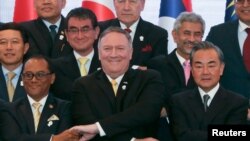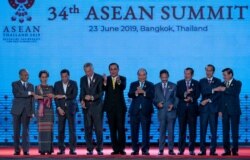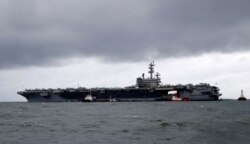The United States and all 10 member states of the Association of Southeast Asian Nations (ASEAN) will for the first time conduct joint maritime drills near the disputed South China Sea.
The drills are expected to last five days, beginning September 2.
Thailand, co-hosting the exercise as this year's chair of ASEAN, denies that the drills aim in any measure to challenge China's mounting efforts to dominate the hotly contested waters. "Nothing to do with China," Thaksaphon Namhom, head of operations and intelligence for the Royal Thai Navy's patrol squadron, told VOA.
But by cutting the waters between southern Vietnam and the Malacca Strait, a critical chokepoint for international trade between the Indian and Pacific oceans, they will be sending Beijing a clear message that ASEAN can partner with whomever it pleases, analysts say. And it just might cool rising tension in the sea, some add, by helping keep China's ambitions in check.
"Ultimately the whole exercise is to show that, you know, there is actually ... freedom of navigation and overflight in the South China Sea, and of course more importantly that ASEAN countries, or the South China Sea littorals in Southeast Asia, they have the right and the freedom to choose who they will want to exercise with, and without coming under pressure from anybody," said Collin Koh, maritime security research fellow at the S. Rajaratnam School of International Studies in Singapore.
Beijing claims more than 80 percent of the South China Sea and has been transforming reefs, shoals and islets in the energy-rich waters into military outposts for the past several years, bringing it into sometimes tense standoffs with the five other claimants — Brunei, Malaysia, the Philippines, Taiwan and Vietnam.
The US-ASEAN exercise along the sea's southwestern flank follows China's own first-ever maritime drills with the bloc in October in the sea's far north. And like those with China, the drills with the United States will wrap up within a week and engage a total of eight ships, according to the Thai Navy.
Analysts say the similarities are deliberate.
"The standard operating procedure ASEAN is using is that it doesn't want to be drawn into any great power configuration," said William Choong, senior fellow for Asia-Pacific security with the International Institute for Strategic Studies in Singapore.
"It's signaling that ASEAN accords equal weight to China and the U.S. ... because a lot of this is about signaling," he said.
China has been putting mounting pressure on ASEAN to tip the scale in its favor, said Carl Thayer, emeritus professor at the Australian Defense Force Academy.
Beijing recently proposed text for a code of conduct it has been negotiating with the bloc to cover the South China Sea, including what he called "a sting in the tail" — for any one of them to hold military exercises with an outside power, all of them would have to agreed.
"In other words, China seeks to bind ASEAN to regular military exercises and reserve the right to veto any ASEAN military exercise with 'countries outside the region,' specifically the United States," he said.
Rather than align with either, the back-to-back naval drills were "a balancing act by ASEAN to treat China and the United States evenhandedly," he added.
The analysts say the coming exercise is also a chance for the United States to signal that its commitment to keeping the region's vital sea lanes open was steadfast.
While matching China's dills with ASEAN ship for ship, Choong said next week's exercise was also a "natural progression" of the drills the United States has been holding with ASEAN countries one-on-on or in smaller groups.
It also coincides with a growing number of so-called freedom of navigation operations the U.S. Navy has been running through the South China Sea to counter Beijing's territorial claims since U.S. President Donald Trump took office in January 2017.
"Taken together with other policy measures being undertaken by the Trump administration, it's meant to highlight the persistence of [the] U.S. presence and interest in the South China Sea," said Koh.
While China was not likely to take the bloc's drills with the United States as an outright threat, he said, Beijing might still see them as a "security challenge." But rather than raise tensions, he added, the balancing act could help keep the peace by raising the prospects that the United States will step in if China crosses any red lines while prodding its neighbors.
"I wouldn't say that it's going to stop coercion completely," Koh said. "But at the very least it's going to ensure that these kinds of actions may not go beyond the threshold into outright use of force."
The analysts agreed that the bloc's exercises with both Beijing and Washington are likely to become regular, if not annual, events from now on.
As Choong put it, they are now "one component of the bigger China-U.S. struggle for influence in the region."








